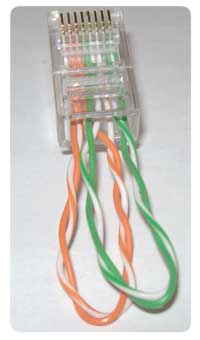
#ETHERNET LOOPBACK CABLE PATCH#
A patch cable may also function as loopback, when applied manually or automatically, remotely or locally, facilitating a loop-back test. Loop around is a method of testing between stations that are not necessarily adjacent, wherein two lines are used, with the test being done at one station and the two lines are interconnected at the distant station.

In telecommunications, loopback devices perform transmission tests of access lines from the serving switching center, which usually does not require the assistance of personnel at the served terminal. Any message transmitted by such a channel is immediately and only received by that same channel. It may be a communication channel with only one communication endpoint. It is primarily a means of testing the communications infrastructure. Loopback (also written loop-back) is the routing of electronic signals or digital data streams back to their source without intentional processing or modification. JSTOR ( August 2020) ( Learn how and when to remove this template message).Unsourced material may be challenged and removed. Please help improve this article by adding citations to reliable sources.

For a diagnostic tool like this to be useful, it has to work 100% of the time, but this experience has shown that it's very flaky.This article needs additional citations for verification.
#ETHERNET LOOPBACK CABLE MANUAL#
Consult the equipment manual of the equipment being tested to determine if gigabit loopback is supportedįrom all my testing and research on this subject my conclusion is that unless you're dealing with exclusively ancient 100Mbps equipment, the loopback adapter concept is now obsolete due to advanced signalling in modern switches. The Gigabit Loopback Jack & Plug is intedned solely for testing systems where the Near End Crosstalk (NEXT) function can be disabled and the equipment under test can support being looped back to itself. Not all gigabit Ethernet systems support loopback operation. Gigabit switches may behave differently (but I’m not sure what the spec says or the real-world variation is)Īlso, even commercial loopback adapters come with a lengthy caveat regarding gigabit compatibility Meaning it’s often only useful on NICs which let you disable crosstalk detection. Gigabit NICs have crosstalk detection (detects how much signal interferes onto other wires), and will likely decide that the loopback is an extreme amount of crosstalk - any may not show link. Turns out "Gigabit loopback is a limited concept" so maybe 100Mbps works ONLY on 100Mbps switch? I could live with that if that's how that works, but what about 1Gbps loopback with 4 pairs? Why is that not lighting up?)Ĭan anyone shed some light on this? I just don't get why it's behaving the way it is. But maybe that's to be expected because that's also what happens when I plug in my other 2 pair 100Mbps RJ45 loopback. The other weird thing is that 1Gbps switch that's 100Mbps capable doesn't detect this at least as 100Mbps (I could live with it not showing up as 1Gig). I also tried several switches, and it's always the same: 100Mbps lights up, 1Gbps doesn't. I'm not new to crimping cables either, so I'm 99% sure I succeeded in crimping it well. I triple checked my pinout and I just can't get it to work. The obvious problem could be that I crimped the cable wrong, but now I'm on the 3rd one and I get exactly same frustrating results.

When I plug it into a 1Gbps port on 100/1G switch the port does not light up.


 0 kommentar(er)
0 kommentar(er)
